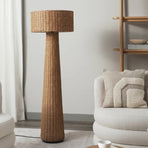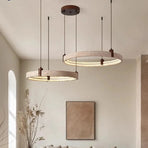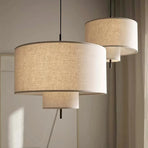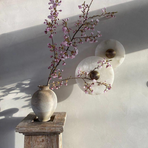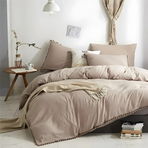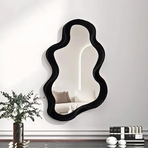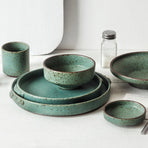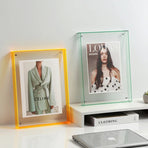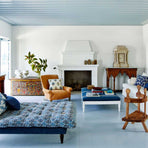Choosing the right lighting can transform the feel of a room, and deciding between pendant lights and chandeliers is key to setting the tone. Each option brings its own unique style and function—pendant lights offer sleek simplicity, while chandeliers provide timeless elegance. In this guide, we’ll break down the defining characteristics of both to help you make a choice that suits your personal taste and meets your space's needs. Whether you’re drawn to the clean lines of pendant lighting or the statement-making presence of a chandelier, we’ll help you find the ideal solution to elevate your interior.

What is a Pendant Light?
A pendant light is a ceiling-mounted fixture that hangs down from a cord, chain, or rod, typically featuring a single light source. Known for their ability to deliver focused lighting, pendant lights are a stylish and functional choice for various spaces. Their wide range of designs makes them incredibly versatile. Below are some of the most popular styles of pendant lights:
- Mini Pendant Lights: Small and compact, these are ideal for use in multiples—often arranged in a row over kitchen islands or counters for a sleek, modern look.
- Multi-Light Pendants: Featuring several lights suspended from one base, these are perfect for larger areas that require broader illumination.
- Drum Pendants: Designed with a cylindrical, drum-shaped shade, these offer clean lines and a contemporary aesthetic. Shades can be crafted from fabric, metal, or other materials to suit different styles.
- Globe Pendants: With a round, glass shade, globe pendants emit a soft, diffused light, making them great for ambient lighting in both modern and classic interiors.
- Rattan Pendants: Crafted from natural woven materials like rattan or wicker, these lights offer a relaxed, organic feel—ideal for coastal, boho, or Scandinavian-inspired interiors.
- Marble Pendants: Featuring real or faux marble accents, these add a refined, elegant touch with their timeless stone texture—great for luxury kitchens, bathrooms, or entryways.
- Industrial Pendants: These feature raw materials such as metal and have a rugged, utilitarian style—perfect for lofts or modern industrial-themed spaces.
- Crystal Pendants: Elegant and luxurious, these include sparkling crystal accents and are commonly used in formal settings to add a touch of glamour.
- Rustic or Farmhouse Pendants: Made with wood, metal, or distressed finishes, these pendants bring warmth and charm to casual or country-style interiors.
- Art Deco Pendants: With geometric patterns, bold shapes, and vintage flair, these are ideal for adding sophistication and historical style.
- Contemporary Pendants: Clean, minimalistic, and highly functional, these pendants suit modern homes with a focus on simplicity and versatility.
When selecting a pendant light, it’s important to consider the scale of the space, ceiling height, and the overall design theme to ensure it complements the room’s aesthetics. Popular finish options for stylish indoor pendants include rattan, fabric, imitation silk, and frosted glass — each bringing its own unique texture and character to enhance the elegance of your space.

Martinelli Pendant Lamp – A contemporary lighting fixture that seamlessly combines refined elegance with everyday functionality
Tahiti Drift Pendant Lamp – Handcrafted from natural rattan and hemp rope, this pendant lamp exudes coastal charm and organic elegance,
What is a Chandelier?
A chandelier is a ceiling-mounted decorative light fixture, typically featuring multiple arms or branches that hold several light sources. Known for their elegance and grandeur, chandeliers often serve as a striking focal point in a room, enhancing the ambiance with a sense of luxury and refinement. Available in a wide range of styles, materials, and finishes, they can complement everything from traditional to contemporary interiors. Here’s a breakdown of some popular types and styles:
- Crystal Chandeliers: Adorned with glass prisms or beads, these chandeliers reflect and refract light to create a dazzling effect. Ideal for formal settings, they exude classic elegance and luxury.
- Candelabra Chandeliers: Designed to mimic traditional candle holders, these fixtures feature arms that hold light bulbs shaped like candles, blending timeless charm with modern versatility.
- Tiered Chandeliers: With multiple stacked layers of lights, these chandeliers add dramatic impact and are perfect for grand entryways, stairwells, or formal dining rooms.
- Drum Chandeliers: Encased in a cylindrical drum-shaped shade, often made from fabric, metal, or glass, these offer a clean, contemporary look while diffusing light evenly.
- Sputnik Chandeliers: A nod to mid-century modern design, these chandeliers have a bold, starburst form with multiple arms radiating from a central sphere — ideal for a modern or eclectic space.
- Rustic Chandeliers: Featuring natural elements like wood, wrought iron, or antlers, these chandeliers lend a cozy, organic feel to farmhouse, lodge, or country-style homes.
- Contemporary Chandeliers: Defined by sleek lines, innovative forms, and minimalist aesthetics, contemporary chandeliers suit a wide range of modern interiors.
- Traditional Chandeliers: With ornate detailing, elegant silhouettes, and classic finishes, these fixtures bring timeless sophistication to any room.
- Farmhouse Chandeliers: Combining rustic finishes with warm, inviting designs, these are perfect for creating a relaxed and charming atmosphere.
When choosing a chandelier, it's important to consider the room’s dimensions, ceiling height, and design style to ensure a balanced and cohesive look. Popular finishes include antique bronze, brushed nickel, polished chrome, and copper, each adding its own flair to the fixture’s visual appeal.

Cynthia Chandelier – A stunning wooden candlestick chandelier, thoughtfully designed to bring both sophistication and warmth to any space.
Christine Ceiling Chandelier – Designed with your choice of polished chrome, gold, or black finish, this elegant chandelier features cascading crystal branches that bring a sense of glamour and sophistication to any room.
Key Differences Between Pendant Lights & Chandeliers
Pendant lights and chandeliers are both popular choices for interior lighting, but they differ significantly in terms of design, function, and usage. Below is a breakdown of their primary distinctions to help guide your lighting decisions:
1. Design & Structure
- Pendant Lights: Usually consist of a single light source suspended from the ceiling by a cord, chain, or rod. They are available in a variety of designs, including minimalist, industrial, coastal, and Scandinavian styles.
- Chandeliers: Characterized by multiple arms or branches that each hold a light bulb. They typically have a more elaborate and decorative structure, often serving as a room’s centerpiece.
2. Size & Scale
- Pendant Lights: More compact and ideal for focused lighting in specific areas like kitchen islands, bedside tables, or hallway corners.
- Chandeliers: Larger in scale and designed to fill and illuminate grander spaces such as dining rooms, foyers, or stairwells.
3. Number of Light Sources
- Pendant Lights: Most feature a single light source, although multi-light pendants are available for broader coverage.
- Chandeliers: Always include multiple lights, offering widespread illumination from a central fixture.
4. Functionality
- Pendant Lights: Often used for task lighting or as accent lighting, depending on placement and style.
- Chandeliers: Combine functional lighting with decorative flair, offering ambient illumination and a strong visual impact.
5. Placement
- Pendant Lights: Ideal for targeted applications, such as over dining tables, kitchen counters, or desks.
- Chandeliers: Best suited to larger rooms with higher ceilings, where they can hang prominently without obstruction.
6. Aesthetic Appeal
- Pendant Lights: Highly adaptable in style, they suit a broad range of interiors, from contemporary to rustic.
- Chandeliers: Often more formal in appearance, they range from classic crystal designs to modern sculptural styles that command attention.
7. Versatility
- Pendant Lights: Extremely versatile and commonly used in both residential and commercial settings, either as standalone fixtures or grouped in multiples.
- Chandeliers: While also versatile, they are more often associated with upscale, formal, or statement-making interior spaces.
While both pendant lights and chandeliers provide essential lighting, their differences in form, scale, and intent make them suitable for different areas and design goals. Pendants offer precision and versatility, while chandeliers bring drama and elegance — the right choice ultimately depends on the space and the atmosphere you wish to create.
Dalarna Pendant Light – Creates a subtle harmony through its elegantly layered lampshades, blending form and function with a soft, ambient glow.
Hjordis Pendant Light – Featuring a sleek, hand-knitted fabric shade that adds texture and warmth to any space.
How to Decide Between a Pendant Light and a Chandelier
Selecting the right lighting fixture—whether a pendant light or a chandelier—depends on a variety of factors, including room size, purpose, style, and personal taste. Below are key points to consider to help you make the right choice:
1. Room Size & Ceiling Height
- Pendant Lights: A practical option for smaller rooms or spaces with lower ceilings. They provide focused illumination and work well over kitchen islands, dining tables, or in reading corners.
- Chandeliers: Better suited for larger rooms with high ceilings, such as formal dining rooms, foyers, or expansive living areas. It's important to choose a chandelier that’s proportionate to the space.
2. Lighting Function
- Pendant Lights: Great for task-oriented lighting or spotlighting specific areas. Ideal for use in kitchens, bedrooms, or workspaces where targeted lighting is needed.
- Chandeliers: Provide general ambient lighting while also acting as a decorative centerpiece. They’re perfect for spaces where a more elegant and dramatic effect is desired.
3. Style and Aesthetic
- Pendant Lights: Available in a vast range of styles—from sleek and modern to rustic and ornate—making them easy to match with almost any decor.
- Chandeliers: Known for their luxurious and eye-catching appearance. Whether your space is traditional, modern, or somewhere in between, a chandelier can enhance the overall decor with elegance and charm.
4. Room Purpose
- Pendant Lights: Well-suited for practical, high-use areas like kitchens or above bedside tables, offering both function and style.
- Chandeliers: Best for formal or communal areas such as dining rooms, entryways, or lounges where you want to make a visual impact.
5. Light Output
- Pendant Lights: Usually feature a single bulb but can come in multi-light designs for broader coverage.
- Chandeliers: Designed with multiple bulbs arranged on arms or tiers to deliver widespread lighting, ideal for filling larger rooms with ambient light.
6. Design Consistency
- Pendant Lights: Adaptable to a wide variety of interior styles—modern, industrial, coastal, or traditional.
- Chandeliers: Often lean toward more formal or statement-driven designs but can also be found in contemporary, minimalist, or rustic interpretations.

Heidi Pendant Light – Featuring a white paper lampshade, this Art Deco-inspired fixture casts a soft, ambient glow, adding elegance and warmth to any interior setting.
Noguchi Wavy Pendant Light – Crafted from high-quality Japanese paper, this piece is inspired by the Wabi-sabi philosophy, embracing simplicity, natural beauty, and imperfect elegance.
Ultimately, the choice between pendant lights and chandeliers depends on your style, the ambiance you want to create, and the room’s needs. Pendant lights offer modern versatility, while chandeliers add timeless elegance. Both enhance your space with beauty and function—choose what best fits your design vision.

